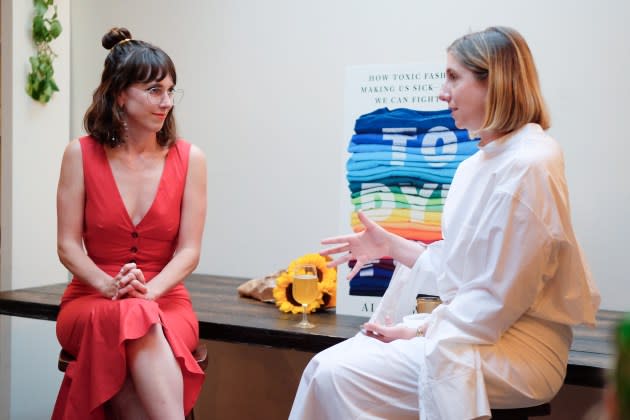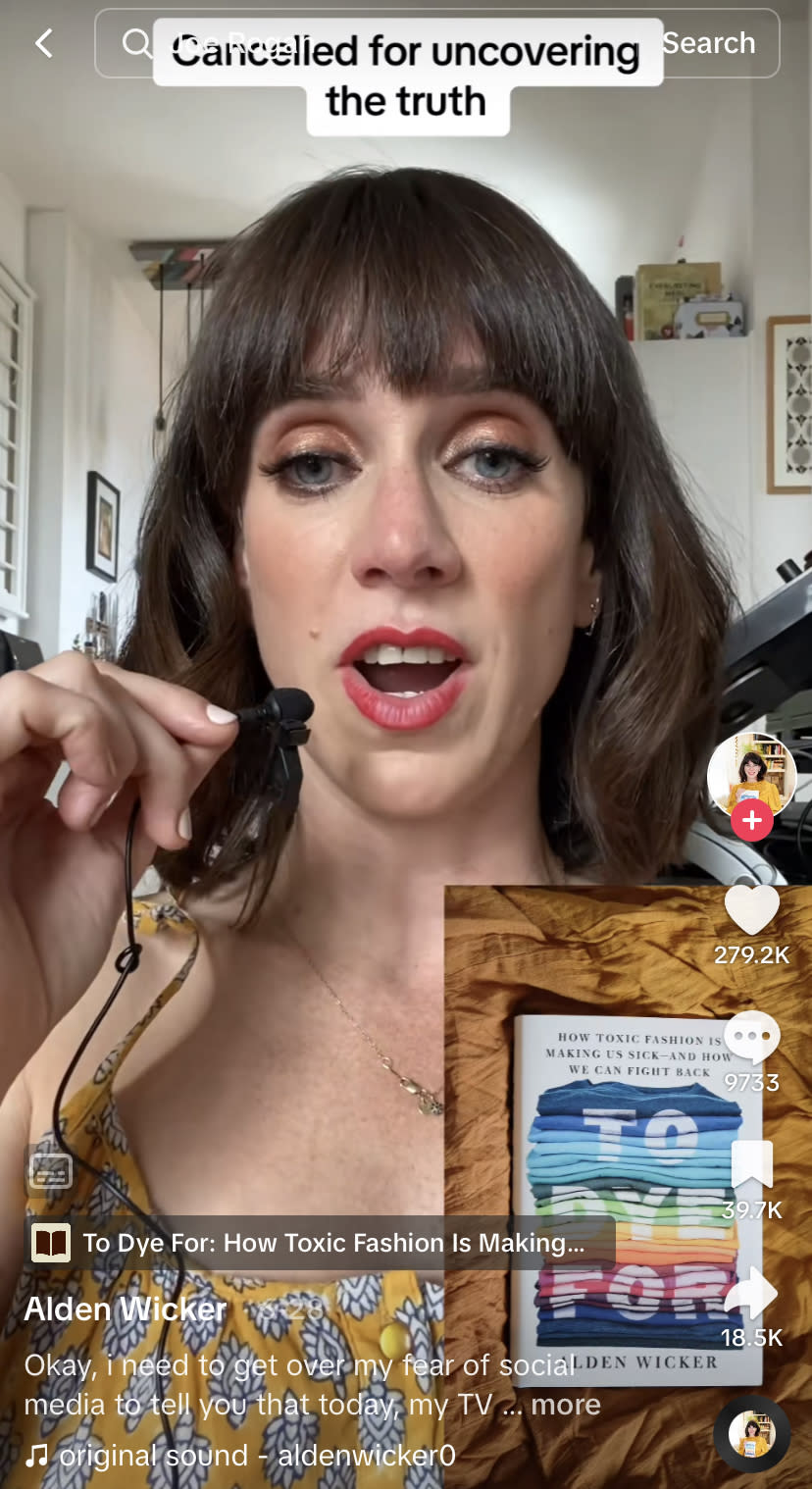Green People: She Exposed Toxic Fashion in ‘To Dye For,’ Found an Audience on TikTok

Authors are finding an embrace for controversial topics online, with toxic fashion being one of them.
In her new book “To Dye For: How Toxic Fashion Is Making Us Sick — and How We Can Fight Back,” Alden Wicker does a deep dive on the hidden toxins lurking in one’s wardrobe. After a canceled TV news segment this summer (Wicker believes broadcast lawyers deemed her information too risky despite the book being fact-checked), she turned to TikTok to detail her findings and found a transfixed audience.
More from WWD
Uyghur Forced Labor Prevention Act Sees Update, Loopholes Remain
Canada Goose Launches Canada Re-commerce, Details PFAS-free Future
'Hibernation,' Brutalism, Climate Key at New York Textile Trade Shows
Here, the author and EcoCult blog founder relays her findings with WWD.
WWD: You mention the Delta flight attendant uniforms as the catalyst for this book. Why do you think this case — and perhaps the Thinx lawsuit — are so captivating for consumers?
Alden Wicker: These two cases aren’t just about toxic chemistry. They’re both an increasingly familiar story about corporate malfeasance, in which brands mislead and even lie to customers and employees to protect themselves and their profit margins. In the case of Delta Airlines, the uniforms were cheaply made, polyester fast fashion, with added layers of chemistry and dyes on top. When attendants started getting sick, Delta Airlines swung into action to protect its image and investment in the uniforms, instead of protecting its employees’ health. It gaslit its own employees by saying there was nothing in the uniforms that could make them so sick. Delta Airlines is not unionized, by the way.
When high levels of fluorine — indicating the toxic class of “forever chemicals” PFAs — were found in Thinx period panties, customers felt betrayed by a company that had claimed to be safe and nontoxic and a women’s company that cared about women. It very well could have been an honest mistake. It was clear that the CEO of Thinx didn’t fully understand how this could happen. But it called into questions the fashion industry’s marketing claims at large. Both cases proved that we can’t really trust corporations to protect our health when it comes to hazardous substances in fashion.
WWD: Did you expect to find an audience on TikTok after the canceled news segment?
A.W.: I had no expectations. I had been told that TikTok could be helpful in selling books by fellow fashion author Amy Odell and low-waste influencer Kathryn Kellogg. I was hoping that if I wrote a really good book and got some legacy media support, it would sell itself. Does that sound naive? I was hoping BookTok [a TikTok niche where authors and readers discuss books] would do it for me. But so far, everyone has been really supportive and wonderful, and if half of the people who say they bought my book actually bought my book? Wow. It’s also such a complex topic that I feel I’m the only one right now who can make accurate content about it. So I guess I’ll keep going!

WWD: What kept you motivated while writing this book? What keeps you motivated against potential retaliation?
A.W.: I went into this research with pure curiosity about what I would find. Honestly, I worried that perhaps I wouldn’t find very much. But it was shocking the stories I found once I started digging in. Toxic fashion has ruined the lives of so many people, including [flight] attendants who lost their whole livelihood (and in one case, their life); fashion employees who have been emotionally and physically abused by the system; children and adults who have scratched themselves raw and not known what was happening to them. Each person who opened up to me and entrusted me with private details drove me forward. Nobody had believed them, not their doctors, not their work managers, not their friends. I felt I had to connect the dots so that at least they could show the book to their friends and say, “See? I’m not crazy. This is real.”
WWD: What do you wear given what you know now?
A.W.: I had already started switching to natural fibers in the past few years, it’s much more comfortable. But now when I see synthetics I have a pretty strong emotional reaction to them. Like, ick. I wear a lot of earth tones, swishy dresses, denim, organic cotton workout clothes with just a bit of stretch. My vibe is somewhere between a homesteader and yoga teacher who lives in Tulum [Mexico].
WWD: Have Zero Discharge Hazardous Chemicals, Bluesign and other chemical management programs helped the industry progress to cleaner ways? Why or why not?
A.W.: ZDHC was a bright spot in my research. It has set a standard for safe chemistry, is transparent in its processes and governance and has done a lot to clean up the industry. Bluesign, which provides on-the-ground active support for ZDHC’s program, is well-regarded for its work in making factories and chemical products safer. Nobody has said a bad word about the work they’ve done, except for the fact that ZDHC is still voluntary. Scott Echols, ZDHC’s chief impact officer, told me himself that it doesn’t cover enough of the industry. The next step is to build on what ZDHC has done by making manufacturer restricted substance lists — which spell out all the hazardous substances not allowed in fashion’s supply chain — mandatory across countries and manufacturers.
WWD: How do you foresee greater accountability happening in fashion?
A.W.: First, fashion brands should be required to provide a full ingredient list on its products. Of course, that would be too long for a typical care tag, so we’ll need QR codes for that. That’s just a basic, so consumers with allergies can choose products that don’t give them a reaction. And I think if consumers saw that, they would be sufficiently freaked out to demand more accountability from the fashion industry and more protection from the government. The Consumer Product Safety Commission also needs a lot more funding so it can do its job to protect consumers from toxic fashion. And the federal government should follow the EU’s lead and ban dozens of known, extremely hazardous substances for use in fashion products.
WWD: Though agencies like the EPA are looking to mitigate PFAs, what pitfalls still exist?
A.W.: The EPA doesn’t govern consumer products. For example, the EPA banned the pesticide chlordane, no exceptions, in the 1980s. But it was found on an airline uniform. There is nothing illegal about it being on a fashion product that is sold to American consumers or forced on employees. As long as PFAs are legally allowed to be bought and used in countries like Bangladesh, Indonesia and Sri Lanka, and the federal government doesn’t ban its presence in all clothing, it will still show up on our clothing.
WWD: What single fact shocked you the most while researching this book?
A.W.: I guess it’s the fact that there are literally zero federal regulations in the U.S. governing what hazardous substances can be put on adult clothing. The federal government only bans three chemicals (out of about 40,000 chemicals being used in commerce today) and just for children’s products. Oh, and Customs and Border Protection doesn’t check any shipment into the country that are worth less than $800. So literally nobody is looking at that fast-fashion package between the time it leaves a factory in China and reaches the hands of your tween.
WWD: What is your biggest call-to-action for consumers? What about for industry?
A.W.: Ask your state legislators what they are doing to protect your and your family’s health from toxic chemicals in consumer products. And for the industry: stop being so lazy and cheap. This is going to come back and bite you if you don’t get your supply chain chemistry under control. The movement is growing.
Best of WWD

